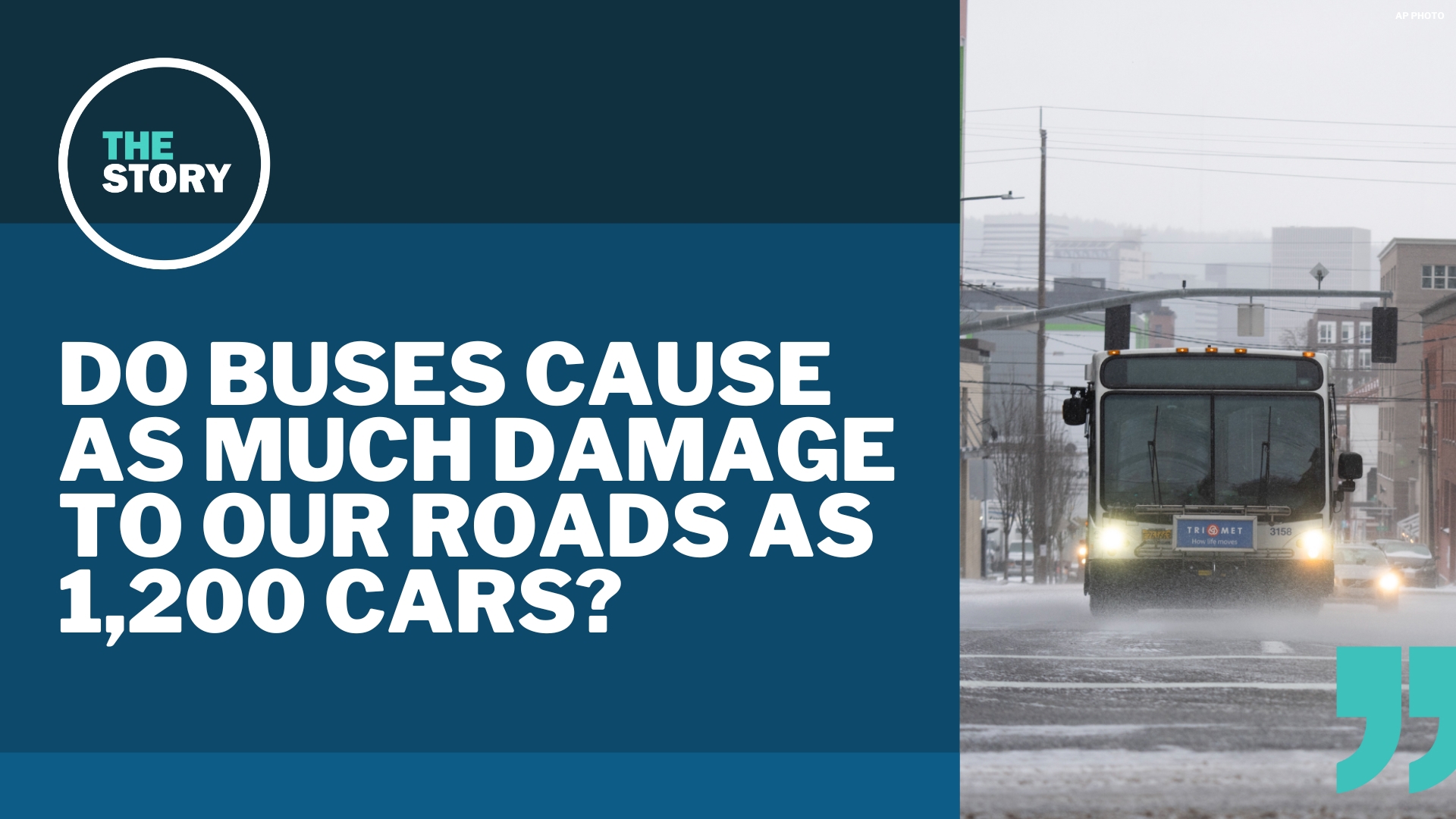PORTLAND, Ore. — During a hearing earlier this month for lawmakers to gather public feedback about how to tackle the Oregon Department of Transportation's funding crisis, one public commenter made a rather eye-popping claim.
During a discussion about how to raise more money to cover the cost of repairing and preserving the state's roads, the commenter argued that public transit riders should help pay for road maintenance because "one two-axle TriMet bus does as much damage to the roads as 1,200 cars," and heavier battery-powered buses will do even more damage.
It stands to reason that one bus would do a lot more road damage than one car, but a city bus only weighs about ten times as much as a small car, so at first glance the 1,200 figure seems impossibly high. But is it actually an overstatement? Here's what we can VERIFY.
THE QUESTION
Can one bus cause as much road pavement damage as 1,200 cars?
THE SOURCES
THE ANSWER
Yes — the difference in damage depends on the weight of the car in question, but going by the average weight of personal vehicles sold in the United States, one bus can cause as much damage than 1,200 cars, if not more.
WHAT WE FOUND
The Environmental Protection Agency's 2023 Automotive Trends Report lists the average weight of a new personal vehicle sold in the United States at 4,303 pounds, although individual vehicles can range from below 3,000 pounds to well over 5,000 pounds depending on the make and model.
The majority of TriMet's bus fleet consists of 40-foot diesel buses. The exact weight can very slightly, according to an agency spokesperson, but a Gillig 3900-series weighs 28,620 pounds without any passengers, so using that number as a general estimate would mean that a 40-foot bus weighs approximately 6.7 times as much as an average personal vehicle.
Other statistics like passenger capacity and fuel efficiency scale at roughly the same pace as weight; a 40-foot bus has about 8 times as many seats as a sedan, and it burns about 6 times more fuel to go the same distance, based on U.S. Department of Energy data.
But when it comes to road damage, the formula is completely different.
A rule of thumb often cited in online discussions is the Fourth Power Law, which holds that as a vehicle's weight increases, the corresponding increase in road damage is equal to the increase in the vehicle's weight-per-axle to the power of four. So if a vehicle's weight doubles, for example, it will cause 16 times more road damage. That's one of the reasons why some big trucks have extra drop-down wheels — distributing the weight of a full load over more axles decreases road damage.
Despite the name, the "law" is really more of a shortcut for making quick approximations in place of a much more complicated formula developed by U.S. highway officials, according to Pavement Interactive. But it does give a good general sense of how pavement damage scales up with weight, and more specific examples in other reports confirm that the law's estimates are at least in the right ballpark.
Applying the Fourth Power Law to the 6.7-to-1 weight ratio between buses and cars, the result would be that one bus does about 2,015 times as much road damage as one average car. Changing it up to compare with more specific car types, the formula shows that a bus does about 8,300 times more damage than a 3,000-pound sedan, but only about 730 times more damage than a 5,500-pound pickup truck.
It's worth stressing again: these are very rough estimates using an imprecise formula that doesn't account for other factors like passenger load, pavement composition or weather conditions. But they're still accurate enough to safely conclude that the person at the public hearing was broadly correct, or even slightly understating things.
When asked for an estimate, a Portland Bureau of Transportation spokesperson told KGW that a fully loaded public transit vehicle can cause as much pavement damage as 10,000 personal cars.
The person at the hearing was also right about batteries increasing road damage; 40-foot battery-electric buses are about 35,100 pounds each, according to TriMet, which according to the Fourth Power Law would mean they'll do a little more than twice the damage of their diesel-powered predecessors (but to be fair, the point of electric buses isn't to decrease pavement damage — it's to decrease carbon emissions, and they're very good at doing that).

